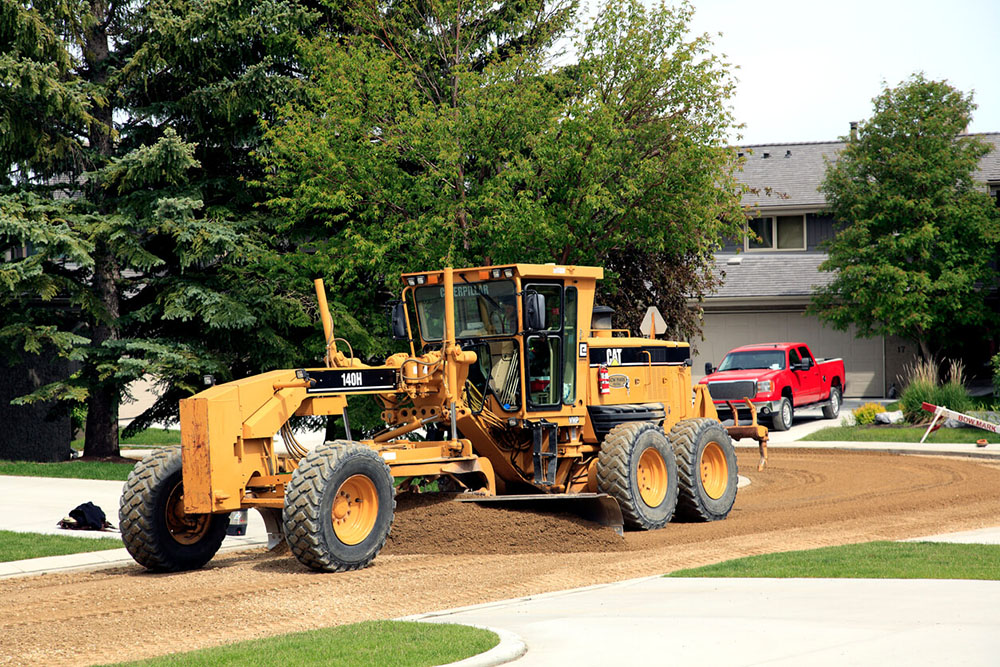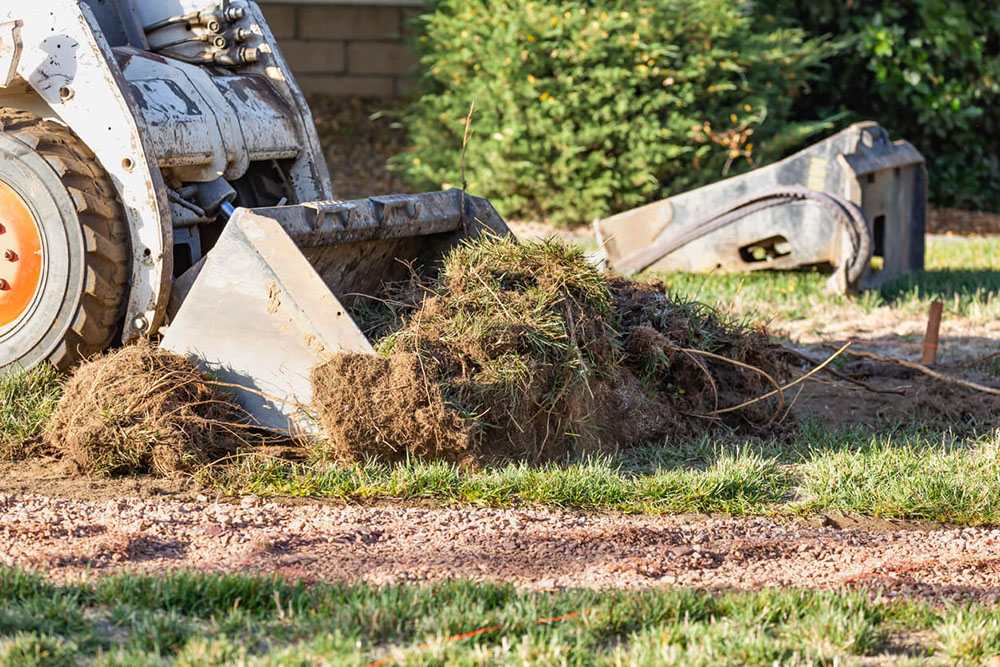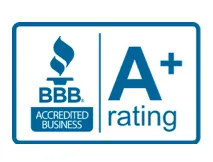Yard regrading is necessary when there are issues with standing water, soil erosion, or poor drainage on your property. It helps to redirect water flow away from structures and prevents damage to the landscape. If you notice pooling water or uneven ground, it may be time to consider yard regrading for better water management and overall landscape health.

Yard Regrading: When and Why It’s Necessary for Proper Landscaping
Ensuring proper drainage and preventing erosion is a challenging task when it comes to maintaining the health and integrity of your yard. Picture rainwater not draining properly, but pooling instead and causing muddy areas that become breeding grounds for insects and waterlogged patches that could harm your garden or seep into the foundation of your home. This is where yard regrading becomes an essential solution.
Yard regrading isn’t just about redirecting water; it’s also about creating a harmonious visual landscape. And who doesn’t want a picturesque yard, right? A well-graded landscape maximizes curb appeal and makes your outdoor space more functional—whether for entertaining, gardening, or simply providing a beautiful view from your window.
Aesthetics and Practicality With the right grading, you can transform a previously uneven, messy terrain into a perfectly balanced land full of life where every plant can thrive. It’s not just about aesthetics; it’s about functionality too. A properly graded lawn allows you to use every inch of your land without being held back by potential water damage or unsafe areas.
Preventing Water Damage
Regrading is imperative when you notice areas of standing water in your yard. Addressing this promptly is crucial because standing water can cause soil erosion, which might lead to structural issues, such as cracked concrete or damage to the foundation of your home.
If left unaddressed, these concerns can escalate and bring about significant aesthetic and structural consequences that may require extensive repair work and be rather costly. Prevention is always better than cure!
For instance, if there are low-lying areas on your property, it’s in your best interest to consider regrading as soon as possible to prevent flooding during heavy rains. Handling the problem straight away will save you money on potential repairs down the line. Furthermore, during winter months, poor drainage and improper grading can lead to ice dams forming on your roof which can result in serious water damage inside your home.
We have covered the significant aspects behind regrading requirements including its visual appeal and its vital role in preventing water damage. Let’s now explore identifying signs indicating the necessity of yard regrading to maintain a healthy outdoor space.
Identifying Signs that Regrading is Needed
When we look out at our yard, it’s easy to overlook some of the subtle signs that might indicate a need for regrading. However, these indicators can tell us a lot about whether our yard needs some adjustments to ensure proper water flow and drainage. Let’s take a closer look at the key signs that could point to the need for regrading.
Standing Water
One of the most obvious signs that regrading may be necessary is the presence of persistent pools of water, especially after rainfall. If you notice large or recurring pools of water in certain areas of your yard, it’s a clear indication of poor drainage. This stagnant water can cause soil erosion and lead to other issues if left unaddressed. Regrading can help redirect water away from the property and prevent potential damage.
Water is essential for our yards and gardens, but when it accumulates in specific spots, it can become problematic. Not only does standing water create breeding grounds for pests like mosquitoes, but it can also create muddy patches that make your yard unusable and unsightly. By addressing this issue through regrading, you can ensure that excess water doesn’t linger in your yard, avoiding problems like soil erosion and preserving the health and appearance of your landscape.
Erosion
Visible soil erosion or washed-out areas are telltale signs of improper drainage. If you notice areas where the soil has been visibly washed away or eroded, it indicates a need for regrading to mitigate further erosion. Erosion can weaken the foundation of your landscaping as well as cause damage to plant roots. Regrading helps to correct these issues by creating slopes and elevations that channel water away from vulnerable areas.
Moreover, erosion can lead to hazardous conditions. It weakens soil structure, compromises the stability of plants and structures, and may even pose safety risks. Addressing erosion through regrading not only maintains the aesthetic appeal of your landscape but also ensures its long-term health and structural integrity.
Uneven Landscape
Another sign that might signal the need for regrading is an uneven landscape. Irregular depressions or slopes in your yard are indicators that proper leveling is required. Regrading can help smooth out these irregularities to ensure a more uniform surface and facilitate optimal water flow and drainage across the entire yard.
Imagine your yard as a series of interconnected slopes and valleys – any deviation from this natural flow could result in localized flooding, puddling, and increased wear on certain areas due to concentrated water flow. By addressing these irregularities through regrading, you promote a healthier, safer, and more beautiful outdoor space.
By recognizing these signs and understanding their implications, you can proactively address potential drainage issues through regrading, ensuring a healthy and aesthetically pleasing landscape for years to come.
In recognizing these signals that point towards needed improvements in yard grading comes an important next step: understanding how to measure yard slope and volume effectively.
Measuring Yard Slope and Volume
To ensure your regrading project yields the desired results, it’s essential to measure the yard’s slope accurately. Utilizing a string level or a laser level helps us pinpoint the high and low points of the ground, understanding where the natural water flow occurs, and determining how to adjust it.
Using a string level involves tying a string between two stakes – one at the highest point and another at the lowest point. The string should be pulled taut, with a level attached to it. This allows us to assess how much change in elevation there is across your yard. On the other hand, a laser level emits a beam of light that shows exactly where your land rises and falls.
Calculating Yard Volume
Calculating the yard volume is another crucial aspect, involving determining how much soil needs to be moved to create the desired slope. Accurate measurements provide us with the groundwork needed to plan out our regrading efforts meticulously while ensuring that we create an environment conducive to proper drainage.
To calculate the area of your yard, multiply length and width measurements together. If unsure about doing this yourself, reaching out to a professional landscaper can ensure precise measurements and calculations. After establishing the area, you’ll then need to multiply it by the intended change in slope – whether you want a 1% grade or something more subtle.
Let’s say your yard is 50 feet wide by 100 feet long; therefore, its area is 5000 square feet. If we wish to raise or lower the landscape by one foot over this entire space, we have now determined we would need 5000 cubic feet of soil.
Accurate measurements provide us with the groundwork needed to plan out our regrading efforts meticulously while ensuring that we create an environment conducive to proper drainage.
Preparing Your Yard for Regrading
Before starting the regrading process, creating a clean slate is essential. Removing obstacles such as rocks, plants, or debris is crucial to ensure a smooth regrading process. These obstacles can interfere with the grading equipment and affect the accuracy of results. Clearing the area not only provides a safe and accessible workspace but also allows us to focus on the yard’s natural contours without any hindrances.
A clear landscape sets the foundation for an accurate regrading process. An area free from obstacles ensures that grading equipment can navigate the space effectively, leading to precise and consistent results. Removing debris prevents interference with the finished grade or causing uneven settling in the future. This step facilitates the uninterrupted flow of the regrading process by enabling our team to work methodically and efficiently.
Think of this step as laying down a clean canvas before an artist begins to paint. Just as an artist needs a smooth, unobstructed surface to work on, we need an uncluttered yard to achieve optimal results during the regrading process. By removing these obstacles, we’re creating a blank canvas for our landscaping experts to meticulously craft and shape the land’s contours, ensuring a professional finish that enhances your overall landscape.
After ensuring that your yard is obstacle-free, marking clear boundaries comes next in preparing for regrading.
The Regrading Process: Step-by-Step Guide
Regrading a yard involves precise steps to ensure proper water flow and landscape stability. This process may vary based on the specific needs of your property, so it’s always good to consult with professionals to assess your land thoroughly.
Excavation
The first step in regrading is excavation. This involves digging out the designated area to adjust the slope and create proper grading. If your yard has low spots where water collects or areas where the ground slopes toward your house, this step is crucial to remedy these issues.
Once the soil is excavated, it might need to be reshaped by either adding or removing soil in targeted areas, ensuring that the new slope is uniform and appropriate for efficient water drainage.
Compaction
Compacting the soil after achieving the desired slope is vital for ensuring stability. A well-compacted base helps prevent soil erosion and settlement over time. Compaction also promotes proper water flow and reduces the risk of future issues related to uneven settling or shifting ground.
Moreover, compacting the soil can enhance the load-bearing capacity of the ground, providing a more stable foundation for any landscaping features or structures that will be added. Proper compaction is essential for long-term durability and functionality of your landscape.
Establishing Drainage
Once grading and compaction are complete, it’s time to implement proper drainage solutions. Drainage solutions such as swales or French drains can effectively direct water away from the property, preventing potential flooding or erosion. These solutions are crucial for maintaining a healthy landscape and preventing future water-related issues.
Swales are shallow ditches designed to carry water away from specific areas, while French drains consist of a perforated pipe surrounded by gravel which helps redirect groundwater away from critical areas of your property.
Properly executed drainage systems can address issues like standing water, mitigate erosion, and prevent future pooling around your property. Ensuring that water flows away from your home will help safeguard your foundation and landscape from potential damage due to excess moisture.
By carefully following these essential steps in the regrading process, you can significantly improve the long-term health, functionality, and aesthetic appeal of your outdoor space.
Aftercare: Testing the Newly Leveled Ground
Following the completion of the regrading process, the real test begins. After rainfall or irrigation, it’s crucial to inspect how well the ground has adapted to its new shape and level. Proper drainage is essential to ensure that water flows away from your property and doesn’t pool in low-lying areas.
Testing the ground for proper drainage involves a visual inspection of how water behaves after being applied to the regraded area. To carry out a simple test:
- After watering, observe how water flows or stands on various parts of the regraded ground.
- Monitor the movement and pooling of water, paying close attention to any areas where water is not draining properly.
- Check for any signs of erosion, which can indicate uneven settling or further regrading needs.
If you notice any issues with water drainage, it’s essential to address them promptly before they lead to more serious problems like soil erosion, foundation damage, or landscape deterioration.
Let me tell you a story about a homeowner who failed to test their newly regraded ground. After a heavy rainstorm, they discovered that water was pooling in one corner of their yard instead of draining away. This caused significant damage to their lawn and led to long-term erosion issues. Had they tested the regraded ground initially, they could have identified this problem early on and taken steps to rectify it.
The importance of this testing process cannot be understated. By taking the time to check the drainage immediately after regrading, you have an opportunity to identify and address any issues before they escalate into larger, costlier problems.
Ensuring that the newly leveled ground has adopted the desired drainage patterns is an essential part of ensuring the success and longevity of your regrading efforts. It helps prevent potential issues and keeps your landscape healthy and beautiful.
In maintaining your landscape post-regrading, ongoing care and vigilance are vital for securing lasting results.
Maintaining Your Yard Post-Regrading
After all the hard work of regrading your yard, it’s important to implement post-regrading maintenance to preserve your investment. Our primary goal here is to keep the yard clear of debris and ensure that any drainage solutions remain unobstructed. This means clearing away leaves, sticks, and other natural debris regularly to prevent clogging of drainage systems, effectively preventing the accumulation of standing water in low spots—enhancing our drainage efforts and maintaining the integrity of the newly leveled landscape.
We aim for a harmonious and balanced landscape, free from any signs of regrading issues. To achieve that, routine inspections are vital. We systematically check for any signs of trouble such as areas with persistent standing water or erosion patterns. It’s essential to catch these problems early on before they escalate into larger issues that would require more extensive interventions. By keeping an eye out for warning signs, we can promptly address them and prevent any potential damage to our carefully crafted landscape.
For instance, let’s look at an area where you notice standing water after a heavy rainstorm. This could be an indication of poor drainage – a classic outcome of incorrect regrading. Prompt action is important: consider improving soil elevation in this spot or consulting a professional if you’re unsure about addressing it yourself.
By adhering to a consistent maintenance routine and being vigilant about these details, we can ensure our beautifully regraded yard continues to serve its purpose without causing us any unnecessary headaches down the road.
It’s easy to overlook the significance of post-regrading care in the excitement of seeing your newly leveled yard, but heed this advice from experience: consistent monitoring and maintenance go a long way in preserving the beauty and functionality of your landscape.
In the next section, we will explore potential regrading challenges that may arise and identify effective solutions to tackle them head-on.
Potential Regrading Challenges and Solutions
Regrading your yard is a significant undertaking, but it can encounter unexpected hurdles that might complicate the process. One of the most common challenges during regrading is the discovery of underground obstacles. These could be old tree roots, large rocks, or even forgotten infrastructure like pipes or wires. Uncovering these during the excavation phase can cause delays and add to the overall cost of the project.
In some cases, soil composition issues might also arise during regrading. The soil may be more compacted or less stable than anticipated, making proper grading and drainage more difficult to achieve. If not addressed properly, these issues could contribute to water pooling in certain areas or poor absorption, leading to erosion and flooding problems.
So what’s the solution when faced with these challenges? That’s where having experts on your side becomes crucial. Professional landscaping companies like ours at cclanddesign.com have the expertise, experience, and equipment necessary to address these obstacles effectively.
Some might consider tackling regrading as a DIY project, but handling these kinds of unexpected challenges without proper knowledge and equipment can lead to costly mistakes and frustrations down the line. In contrast, partnering with professionals ensures a smoother process with access to specialized tools for excavation and assessment of soil conditions.
For instance, if underground obstacles are encountered, our team would have the means to carefully remove them while minimizing disruption to your yard. Moreover, when it comes to soil composition issues, we possess the expertise to assess the soil quality accurately and implement any necessary amendments or enhancements to ensure optimal performance.
By choosing a professional landscaping company like ours, you’re not just investing in the physical work; you’re also benefiting from our wealth of experience in overcoming challenges that might arise during regrading projects. It’s this combination of expertise and materials that sets our service apart, ensuring your yard regrading project goes smoothly from start to finish.
With these insights in mind, it’s crucial to recognize that professional help can significantly enhance the success of your regrading project and save you time, money, and potential headaches in the long run.
Ready for professional guidance on your regrading project? Make sure to reach out for expert assistance from our team today at cclanddesign.com/contact-us/ or call Mario at (504)415-1438.




